Completing a veterinary degree—with four years of intensive classwork, clinical rotations, surgeries, community outreach, and more—takes perseverance.
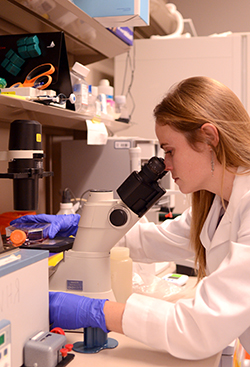
So does earning a PhD. It takes exceptional dedication to do both.
Penn Vet’s VMD-PhD Program, which trains students to be both veterinarians and scientists, attracts passionate and brilliant students who commit to an average of eight years honing their research and clinical skills. Ultimately, they find themselves well equipped to be leaders in their chosen fields, including academia, biotechnology and pharmaceutical industries, government agencies, and more. And with a growing focus on the concept of One Health—recognizing the connections between human, animal, and environmental health—veterinarian-scientists are in great demand.
A Pioneering Program
From its very start, the dual-degree program was imagined as a world-class training ground. Dr. Ralph Brinster, a pioneer in reproductive biology, was the program’s founding director, launching it in 1969 with support from Penn Vet’s Dean at the time, Dr. Mark Allam. To kick off the program financially, they applied for and received support from a Medical Scientists Training Program (MSTP) grant from the National Institutes of Health (NIH).
“The same innovative spirit and creativity that led Ralph Brinster, under Dean Allam’s leadership, to pursue the NIH grant to found the program in the first place, characterized the program and fostered these qualities in the trainees,” said Penn Vet Dean Joan Hendricks, who earned her VMD and PhD through the program in 1980.
Though MD-PhD programs were available and catching on, Brinster and other leaders had a prescient intuition that veterinary science was a field on the brink of blossoming. They believed that well-trained students, with a firm command of both medicine and hard-hitting scientific research, would have important roles to play in society.
“Dr. Brinster’s view was that there would be no watering things down, no scrimping on the PhD,” said Dr. Michael Atchison, current Director of the VMD-PhD Program and Professor in the Department of Biomedical Sciences at Penn Vet. “The goal was to produce outstanding scientists.”
Penn’s medical school also had its own MSTP grant until 1979, when the NIH said that Penn could only have one. Since then, Penn Medicine and Penn Vet have shared one MSTP grant, though the vet school now also has assistance from a second NIH grant through the National Institute of Allergy and Infectious Diseases, as well as support from the Dean’s office, scholarships, and other sources.
In its 47 years of existence, the program has had only four directors. After Brinster, program alumni Drs. Richard Miselis and John Wolfe followed as leaders. Atchison has been director since 2001.
“These are brilliant, high-flying students, and it’s a lot of work but also an honor to support them,” Atchison said.
A “Synergy” of Science and Medicine
Certainly many students in veterinary school excelled in science leading up to their professional degree, and many PhD students may have an interest in animal medicine. But Atchison says successful dual-degree students have passions that distinguish them.
“They must have a drive to be scientists,” he said. “That almost has to be their number-one passion because doing science is hard and it’s a long program. And, of course, they also need to love veterinary medicine, and going through vet school is no easy feat either.”
The program is designed so that students always have a foot in both science and medicine.
“They are working toward both degrees all the time, but at different times they’re working more on one than the other,” Atchison explained.
He described the structure as a vet school-grad school-vet school sandwich. Students begin with a full veterinary curriculum for two years. During the summer months in between, they rotate through labs in their graduate groups of choice to help them identify which will become their home base during their PhD. Then, they transition into their PhD coursework and research. Once they have finished and defended their dissertation, they return back to the vet school full time to fulfill the clinical requirements of the VMD degree.
This interwoven approach is intentional. “When you’re doing medicine you’re thinking science, and when you’re doing science you’re thinking medicine,” Atchison said, adding that, “By intertwining them in this way, there is synergy.”
According to current VMD-PhD student Sylvia Qu (see Research Brief), taking the core veterinary courses before embarking on PhD work in bioengineering and orthopedic surgery was an asset.
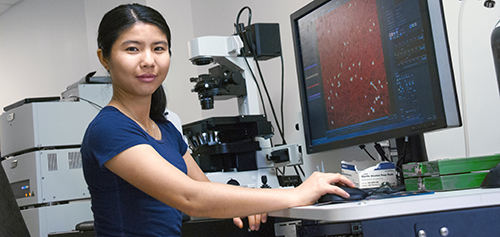
“I was exposed to everything from anatomy and physiology to more specific classes like orthopedics and surgery, which really smoothed my transition to the engineering school where I worked with surgeons every week,” Qu said. “Looking at translational animal models was very comfortable for me at that point.”
Each student meets with Atchison formally at least once a year and again with another advisor in the program. Atchison noted that he gives informal advice far more often than that, helping students weather the ups and downs of scientific research and coursework demands. He and the other leaders of the dual-degree program, including Drs. Nicola Mason, Susan Volk, Bruce Freedman, and Michael May, organize lectures, career development panels, and other professional development workshops for the students to hone their skills in grant writing and presenting their work.
An Unparalleled Environment
Atchison isn’t shy about extolling the virtues of Penn’s program, such as the strength of the University’s biomedical research. The University is consistently in the top three academic recipients of NIH funding and is home to 600 research laboratories. Penn Vet also has the only VMD-PhD program with dedicated NIH funding.
“Most vet schools aren’t in that type of environment,” Atchison said.
Penn’s notable embrace of interdisciplinary research means that graduate groups span across schools, providing a path for students to find the mentor best suited for their interdisciplinary work.
In addition, Penn Vet’s Ryan Hospital and New Bolton Center hospital have significant caseloads, with more than 34,000 patient visits a year from which the students can learn—not to mention renowned faculty engaged in cutting-edge research in a range of basic and applied science disciplines.
Furthermore, the program is able to offer a compelling financial package to VMD-PhD students: their tuition is free, and they receive a stipend equivalent to other biomedical science PhD students. For those reasons, when Atchison makes an offer to come to Penn, applicants rarely say no.
Reaching Across Schools
Most students wind up pursuing their PhD in one of Penn’s nine Biomedical Graduate Studies groups, which span the University’s schools and focus on fields such as immunology, epidemiology, biochemistry, and cell biology.
“Faculty love having combined-degree students in their labs,” Atchison noted.
Most often, students pursue their doctoral degrees with a faculty member in the School of Medicine, but students have also partnered with professors in the School of Arts & Sciences, the School of Engineering and Applied Science, and even the School of Design (on a project looking at how urban planning can improve food flow through cities). And, of course, many study under faculty at Penn Vet.
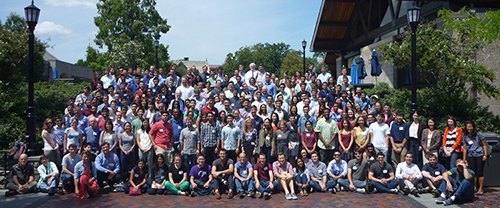 “We’re lucky that Penn is an interactive place that emphasizes interdisciplinary work,” Atchison said. “The goal is to keep the walls and barriers low.”
“We’re lucky that Penn is an interactive place that emphasizes interdisciplinary work,” Atchison said. “The goal is to keep the walls and barriers low.”
VMD-PhD students also meet monthly with MD-PhD students—“kindred spirits,” as Atchison calls them—to share their work in a “Grand Rounds” format, presenting a clinical case and then discussing the basic science that underlies it. Additionally, the VMD-PhD and MD-PhD program participants have a shared annual retreat each summer, where students report on their research progress and learn about clinical specialties.
Through nearly a decade of intensive schooling, a support system is essential. The VMD-PhD Program encourages community and camaraderie, including a night out on the town to welcome new students to the program, a yearly barbecue, a holiday dinner at Atchison’s home, and spontaneous outings throughout the year.
“The VMD-PhDs are a close-knit group,” Qu said.
Making an Impact
The dual degree also gives VMD-PhD students the combination of in-depth molecular medicine, whole animal biology, and understanding of multiple species that a VMD or a PhD student may not have without the other degree. Their uniquely robust skill set readies VMD-PhD students for careers in a plethora of fields.
Atchison noted that VMD-PhD students have excelled in infectious disease research. Because roughly three-quarters of new infectious diseases found in humans have their origins in animal species—illustrated by Ebola, SARS, and West Nile outbreaks, to name a few—a veterinary perspective and deep understanding of zoonotic disease transfer can be crucial for public health response efforts as well as addressing epidemiology, biosafety, and bioterrorism issues.
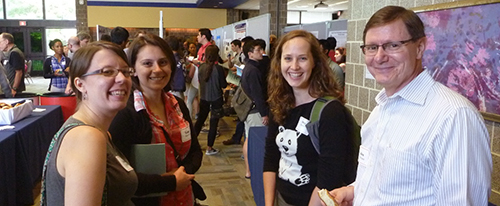 Similarly, a nuanced understanding of comparative biology makes VMD-PhD students uniquely qualified for careers in biomedical research. Many have gone into careers in cancer biology, helping translate research in animal models to humans.
Similarly, a nuanced understanding of comparative biology makes VMD-PhD students uniquely qualified for careers in biomedical research. Many have gone into careers in cancer biology, helping translate research in animal models to humans.
The success of the program’s 73 graduates to date is backed up by rigorous tracking, facilitated by a biannual newsletter to maintain the sense of community in the program. Describing the majority of graduates, Atchison said, “They’re veterinary scientists in either academia, biotech and pharma, or the government, and many tend to be in high-level positions.”
Indeed, at least a third of those in academia—graduates’ most common career track—are in leadership positions, such as chairs or chiefs of departments. Of those in the pharmaceutical or biotechnology industries, more than half are presidents, chief executives, or vice presidents of their companies. Several in government agencies also serve in top positions. Many have found successful homes at Penn Vet, including Dean Hendricks.
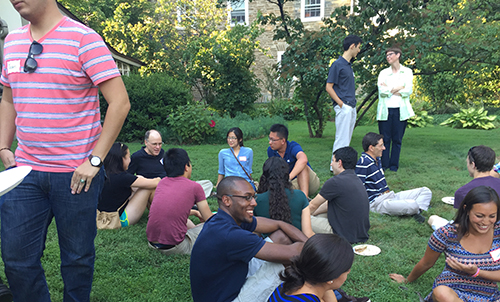
“As one of the early graduates of the VMD-PhD Program, I tremendously enjoyed the freedom to explore the remarkable strengths of Penn’s biomedical community without constraints,” she recalled. “In all facets of the education and training there was rigor, encouragement to think for ourselves, and applause if we showed independent thought
processes.”
The latest crop of students is already making a mark in fields ranging from cancer biology to engineering.
Graduate Nikkita Patel, who finished the program last year, pursued her PhD in epidemiology, working with advisor Dr. Gary Smith, Professor of Population Biology and Epidemiology at Penn Vet. She published some of her thesis research in Proceedings of the National Academy of Sciences—one of the world’s most-cited and comprehensive multidisciplinary scientific journals—on using network analysis to track the countries most intensely tied to webs of wildlife trafficking.
Laurel Redding, who also completed the program in 2015, traveled to the northern highlands of Peru as part of her PhD research. She interviewed smallholder farmers and monitored dairy cow herds in order to understand antibiotic use and the resulting safety of milk products. She found that while farmers were aware of the risks of antibiotic use, the vast majority continued to sell tainted milk, highlighting a need for accountability and incentives for the individual producers.
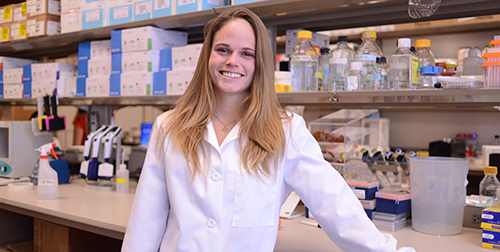 Back on campus, several students have recently defended their theses successfully, or are on the cusp of doing so.
Back on campus, several students have recently defended their theses successfully, or are on the cusp of doing so.
Rebecca Evans, who received a full pass on her defense in November, worked with her advisor, Penn Medicine’s Dr. Robert Vonderheide, to investigate the role of the immune system in combating pancreatic ductal adenocarcinoma—a notoriously difficult-to-treat cancer.
“I chose to enroll in the dual-degree program because I wanted to fulfill my childhood dream of becoming a veterinarian. But I also wanted my veterinary career to impact the health of people,” Evans said. “Cancer biology is an excellent platform for translational research because human and animal cancers share the same pathophysiology. So, cross-talk between veterinarians and physicians could greatly facilitate the development of new treatments.”
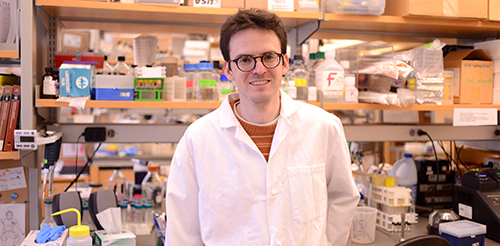 Jeffrey Carey is in the midst of his doctoral work on how bacteria regulate gene expression to anticipate changes in their environment. He hopes to defend his dissertation later this year.
Jeffrey Carey is in the midst of his doctoral work on how bacteria regulate gene expression to anticipate changes in their environment. He hopes to defend his dissertation later this year.
“I’m particularly interested in the regulation of respiratory pathways, which need to be properly coordinated with fluctuations in nutrient availability in order for bacteria to survive and thrive in complex environments,” such as the gut of a host, Carey explained.
Advised by Dr. Mark Goulian, Professor in the School of Arts & Sciences’ Biology and Physics & Astronomy departments, Carey brings a unique perspective to his research. “Being in the combined-degree program has given me a background in animal physiology and pathology that’s been valuable in formulating the basic microbiology questions I try to address in lab,” he said.
A Growing Need, An Expanding Program
The National Academy of Sciences has published several reports demonstrating an acute national shortage of veterinarian-scientists needed for industrial, academic, and government positions.
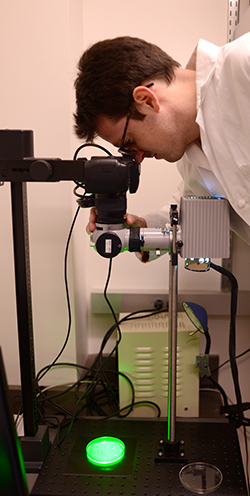 Coming up on a half-century of existence, the VMD-PhD Program continues to grow to meet this demand. Program participation has doubled since 2002, with 22 students currently enrolled.
Coming up on a half-century of existence, the VMD-PhD Program continues to grow to meet this demand. Program participation has doubled since 2002, with 22 students currently enrolled.
“We knew we were doing a good job of producing successful graduates,” said Atchison. “It made sense to build the program so we had a critical mass on campus and also helped meet the societal need for veterinarian-scientists.”
Applicant numbers are at an all-time high, with nearly 50 per year. The admission process
remains highly competitive, with about three to four students accepted each year.
To build on the program’s success, Atchison is working with colleagues at other universities to help them improve or grow their own combined-degree programs. His hope is that NIH begins to support more than just the Penn program.
“More and more, there is a recognition of how important veterinary-scientists are,” Atchison said. “I’m hopeful that along with this recognition will come more support to put
these innovative minds to work around the country.”
Our Supporters
In addition to NIH funding, which covers part of the total cost of the program, the VMD-PhD Program has thrived due to the generous support of Mindy and Andrew Heyer, Drs. Francine and Barnett Rattner, Mark and Tracy Spitzer, the Armour Lewis Family Foundation, and Penn Vet alumni. Increasing endowment resources for the program remains a priority for the School. For information, please contact Jillian Marcussen, Director of Development, at 215-898-4235 or jillian2@vet.upenn.edu.